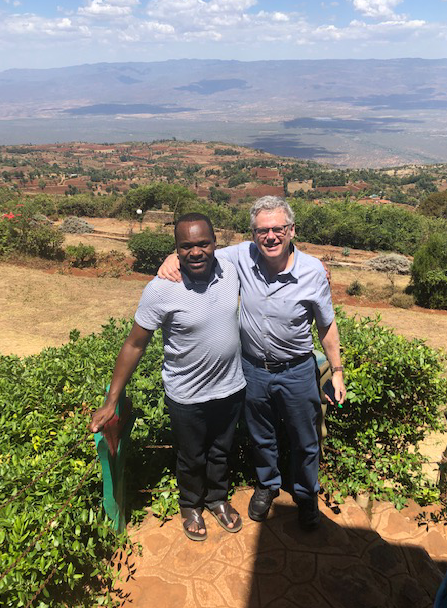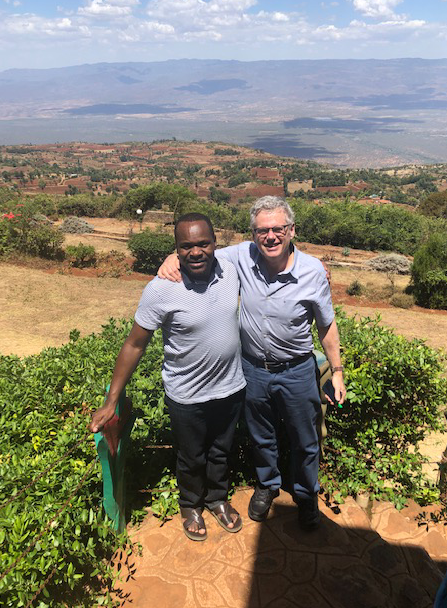Reflections from Ten Years of Gynaecologic Oncology Work in Kenya

 Written by: Dr. Barry Rosen, Past Professor with the University of Toronto's Department of Obstetrics and Gynaecology
Written by: Dr. Barry Rosen, Past Professor with the University of Toronto's Department of Obstetrics and Gynaecology
I have just completed my tenth-year visit to Kenya, a major anniversary for my involvement with the AMPATH program. This program, initiated by Dr. Alan Bocking and led in our department by Dr. Rachel Spitzer, has been a big success in terms of engaging with Kenyan physicians; enhancing care for patients; as well as providing international health electives for UofT medical students, residents and fellows. In addition, it has provided us with opportunities to collaborate with Kenyans in research activities, as well as funding for Kenyan physicians to travel to Canada for further training.
Even though I am no longer at UofT, my identity in Kenya is through Toronto and as a Canadian. So, when I write the word “our”, as in our university, or use “we” please allow me the latitude.
We joined AMPATH in 2008, which as most of you know is a collaboration between North American medical schools, and the Kenyan Moi University and Moi Teaching and Referral Hospital (MTRH). At the time we did not know exactly what our involvement would be or how long we would stay. It’s now been 11 years!
AMPATH (Academic Model to Provide Access to Care) is led by Indiana University and through the leadership of Dr. Joe Mamlin and Dr. Bob Einhertz this program is welcoming, engaging, supportive and inspiring. It is also expansive. For example, they are one of the largest HIV/AIDS treatment programs in the world, having delivered care to over 200,000 individuals. In the past nine to ten years they have expanded from HIV to non-communicable diseases including cardiac care and hypertension, diabetes and cancer care.
During these past ten years, the University of Toronto Department of Obstetrics and Gynaecology has made significant contributions to this program and has taken a leadership role in woman’s health. For example, prior to our involvement Moi University did not have any subspecialty training programs in any fields, including subspecialties like cardiology, GI medicine, or in any surgical subspecialty. That changed because of us and now they have gynaecologic oncology and maternal-fetal medicine (MFM) fellowship training programs. I initiated the gynaecologic oncology program in 2013, with Dr. Nan Okun initiating the MFM in 2018. These are the first two fellowship, subspecialty training programs at Moi University.
I will now reflect on my own experiences in gynaecologic oncology.
Background for Gynaecologic Oncology
When I first went to Kenya in 2009, there was only one gynaecologic oncologist in the country located in Nairobi. He was a senior individual who was trained in Sweden in the 1970s with what he told me was a three-month observational experience. He practised at the largest hospital in Kenya: Kenyatta Hospital.
In 2009, it was obvious that the cervix cancer was the biggest oncology challenge and almost all women with it presented in advanced stages (3B or 4). At that time little was done for them. Most presented with bleeding, pain, a foul discharge and very low haemoglobin. In general, they would be transfused and discharged, but also advised that they could get radiation in Nairobi. The wait time for radiation treatment in Nairobi, the only centre, was three to four months and very few, if any, had the means to travel and pay for the treatment.
The gynaecologic oncology program initially started as a cervical cancer screening program. From 2009, the gynaecologic oncology program evolved extensively and it now includes cervix cancer screening; surgery for early-stage cervical cancer; and ovarian cancer surgery, while also providing chemotherapy and palliation when necessary. This program now provides comprehensive care for all women with a gynaecologic cancer.
The crowning achievement has been the gynaecologic oncology fellowship that started in 2013. To date, six gynaecologists have graduated and two others are in training. This program is recognized by the Kenyan Obstetrical and Gynecology Society (KOGS) and by the Kenyan Medical and Dental Board, the licensing body in Kenya for physicians. It was also the first gynaecologic oncology fellowship in sub-Saharan Africa, outside of South Africa.
Today there are three trained gynaecologic oncologists at Moi University, one in Kisumu, one in Garissa and one in Uganda, the only gynaecologic oncologist in this country. There are two other gynaecologic oncologists in Nairobi, one who trained in Calgary and the other trained in South Africa.
The gynaecologic oncology program has screened over 80,000 women for cervix cancer. They have done 225 radical hysterectomies and have treated a large number of women with high-risk GTN, ovarian and vulvar cancer. They routinely prescribe paclitaxel, carboplatin, BEP and EMACO, and have weekly tumour boards and journal clubs, while also being members of the International Gynecologic Oncology Society (IGCS). They collect data on all patients they see and treat, facilitated by a data manager who we initially hired and who is now paid through grants. Over the past seven years, they had over six million US dollars in grants, mostly from NIH.
The fellowship was designed to be very similar to fellowship training in Canada, and on a day-to-day basis, they function in a similar way that we do, with tumour boards, etc. The Kenyan gynaecologic oncologists have an excellent knowledge base, are current with the published literature and the fellowship program has become an IGCS recognized site for fellowship training in Africa.
It’s truly a remarkable accomplishment in a relatively short period of time. To get where they are today involved a large team of players including many Canadian gynaecologic oncologists who travelled to Kenya to teach. Many others have been involved, but most of the credit goes to the Kenyans themselves who worked hard in their training and who want to make a difference in their country. They are committed to the public sector, which is a sacrifice to their own income by limiting their private practice. Management of this program has been completely transferred to the Kenyans and we act as educators for fellows and residents.
Issues in Kenya
However, all is not rosy. The incidence and mortality from cervix cancer are still rising in Kenya when it is decreasing in many other parts of the world, including Canada. The increase is happening at the same time that maternal mortality is decreasing. In 2005, the same number of women died from pregnancy causes as died from cervix cancer, roughly 500,000 worldwide. In 2018, worldwide maternal mortality has dropped to just over 300,000, whereas the incidence of cervix cancer rose to 560,000, a significant increased based on Globcan 2018.
This could and will change when the HPV vaccine becomes more available. Right now, it is not widely used because of the cost.
Socioeconomically, the women who get cervical cancer are the same population that die in pregnancy and get HIV. Poverty is by far the most important determinant of health in Kenya, as it is in many countries. Poverty translates into poor access to care, inability to pay for it, and a lack of access to knowledge about healthcare. Cultural barriers exist including reliance on traditional healers in the villages which can play a role in the delay of treatment. Interestingly, after Kenya made prenatal care and hospital delivery free, there was an increase in women who sought to deliver their babies in a hospital setting rather than in the village. Overcoming the cost of care made the difference. In the past three years, Kenya has introduced a national health insurance program (NHIF) at a low monthly cost, which covers all cancer treatment when given in a hospital. This too is changing the landscape such that the number of patients seeking care is growing rapidly. For example, in 2017 the group at Moi saw 188 cervical cancers and in 2018 that number rose to 342.
Every time I go to Kenya I am always shocked and surprised at the large number of women with cervix cancer. In the clinic last week, 45 patients were seen, more than 20 had advanced cervix cancer and seven were newly diagnosed. One 27-year-old with five children stands out to me because her creatine was greater than 800. Nephrostomy tubes were out of reach financially and, while radiation was possible, chemotherapy was out of the question unless her creatinine could be corrected. It is highly unlikely she will have the funds to travel to Nairobi for radiation, with a wait time now of six to eight weeks to start the treatment.
In the same week, four new patients with cervix cancer were admitted to the hospital because of pain and bleeding, all requiring transfusion. In the hospital, there was also a 16-year-old whose mother refused to let her get chemotherapy in November after being diagnosed with a yolk sac tumour. She was so wasted and had a performance status four that she died from this germ cell cancer, despite getting treatment for it. Another patient admitted, a 22-year-old with heavy vaginal bleeding from a GTN vaginal metastases, was bleeding so heavily that when her case was presented at the tumour board the fellow described the bleeding as torrential. Her haemoglobin was 33, and she survived because of some great care she got from one of the gynaecologic oncology fellows who was called in at two in the morning. All this activity in just one week, can you imagine?
To provide care to this patient population, which has very complex problems, requires subspecialty training and dedication. I wonder about the rest of Kenya, where there is no gynaecologic oncology expertise. What happens there?
is no question, collectively we from the University of Toronto have made headway and our successes occurred because of the involvement of many people, support from our university department and our opportunity to integrate into AMPATH. I have led the oncology portion of this and it has been very gratifying, but at the same time frustrating and at times emotionally draining.
We, obstetricians and gynaecologists at the University of Toronto are so good at what we do, you do not realize it until you travel outside and see what others are doing. We, Canadians, have a lot to offer and I would encourage anyone with even a remote interest to give it a shot. I promise you will find it a gratifying. You will gain a firsthand understanding of how women in most of the world live, and you will be grateful that you can give back. It will be an adventure, not an easy one, but it will be one where you will shine because of your training and skills.
______________________________________
Don't want to miss a post? Follow us on social media for more news!
FACEBOOK | INSTAGRAM | TWITTER
If you would like to be a guest blogger, please contact us at obgyn@utoronto.ca.
